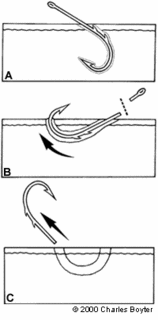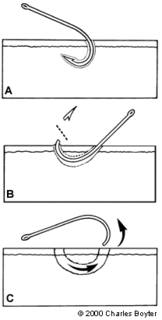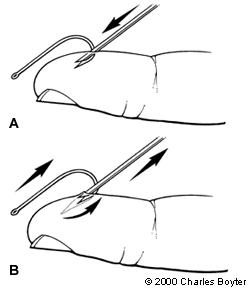Fishing First Aid : Removing a Fishing Hook
 Ouch!...every real fisherman will get a hook embedded somewhere, but hopefully not a vital part. OK so here is a short guide to removing the hook.
Ouch!...every real fisherman will get a hook embedded somewhere, but hopefully not a vital part. OK so here is a short guide to removing the hook.1. Don't panic. Cut the line attached to the hook, sit down in a safe area with a table and good light. Ok now scream for help!
2. Assess the location of the hook. Is it deep or superficial.
*** Do not attempt to remove a fishhook that is deeply embedded, lodged within a joint or tendon, or located in or near an eye or artery.
3. OK there are mainly 3 methods of removing the hook.
A.String-Yank Method.
 In this method, take a long piece of fishing line, loop it around the shank. While pressing on the hook eye, yank the linesharply, parallel to the skin and in line with thehook, to snap the hook back out of the wound.
In this method, take a long piece of fishing line, loop it around the shank. While pressing on the hook eye, yank the linesharply, parallel to the skin and in line with thehook, to snap the hook back out of the wound. I like this comment made by the author:
"This method is quick, simple and relatively painless, as long as you get it on the first try. The secret to a first time success is yanking the loop of line, which is wrapped around the embedded hook, rather hard so the hook comes out on the first try. The reason you should get it out on the first try is obvious, the patient might not stick around for a second try."
B. Advance & Cut Method
 Advance and cut method: single-barbed fishhook. (A) The fishhook is advanced through the skin. (B) The barb is then cut off and (C) the remaining hook is backed out through the entry wound
Advance and cut method: single-barbed fishhook. (A) The fishhook is advanced through the skin. (B) The barb is then cut off and (C) the remaining hook is backed out through the entry wound Advance and cut method: multiple-barbed fishhook. (A) The fishhook is advanced through the skin. (B) The eye of the fishhook is then cut off and (C) the remaining portion of the fishhook is pulled through the exit wound created by advancing the point.
Advance and cut method: multiple-barbed fishhook. (A) The fishhook is advanced through the skin. (B) The eye of the fishhook is then cut off and (C) the remaining portion of the fishhook is pulled through the exit wound created by advancing the point. C.Needle Cover Method
 (A) Advance an 18-gauge or larger-gauge needle along the fishhook until the needle opening covers the point. (B) The fishhook and needle are then removed at the same time.
(A) Advance an 18-gauge or larger-gauge needle along the fishhook until the needle opening covers the point. (B) The fishhook and needle are then removed at the same time. 4. After patting yourself on the back for the successs of your major brain surgery, wash the wound with an antiseptic like flavin or diluted dettol....this part hurts! Squeeze out the blood and bits of worm bait too. Dress the wound lightly with a small plaster, not tightly. Only apply pressure if the wound is bleeding a lot.
5. You need to get a Tetanus injection within 24 hours of the injury. The tetanus shot lasts 10 years, so you can go ahead and hook yourself again anytime after that.
OK I actually just removed a hook from Mrs. Aru's finger 2 weeks ago. Firstly I realised that you must have a small first aid kit with some alcohol swabs or dettol, Cotton wool, plaster and if possible a sterile needle or clean cutting plyers. I will write another article on a fishing first aid kit soon.
Well the hook was a small one, but the barb had gone in just under the skin. So I tried method A. I yanked...it didn't budge. I yanked hard again...and a third time...ohoh. Luckily Mrs Aru has an amazing tolerance of pain...
After that I had to do method 3, slightly modified as I only had a small sterile needle, but it worked. I washed the wound, put on a plaster and gave her a tetanus jab the next morning.
OK So there you go. I hope this will be useful to you!
Additional Thoughts :
One of the benefits of fishing with a barbless hook is that it's much easier to take out if u hook yourself. Also please be careful when you cast, be aware of who is around you.Lastly try not to tie on your hooks onto the leader with a weight attached. Often the weight drops and pulls the hook into your finger.
When NOT to remove the hook...
1. If it's in the eye or anywhere near it.
2. If it's in a joint, tendon or nerve
3. If it's in an artery eg. your neck or groin. To check,feel the area where the hook is. If it is throbbing or pulsatile, it's an artery.
4. If you are unsure or too chicken.
In which case it's better to go to the nearest clinic or hospital.
Treble hooks are bad news...basically the method is the same but you probably have to cut the trebles and treat them as separate hooks.
One more thought...why don't you practice removing the hook? Get a fish hook and hook it onto a piece of leather, orange or hard plastic. Then try using the methods described in the article. If you can get someone to volunteer even better!
(*Disclaimer : The information above is presented in good faith but we will not be responsible for any injury or damage as a result from the techniques above.)



0 Comments:
Post a Comment
<< Home